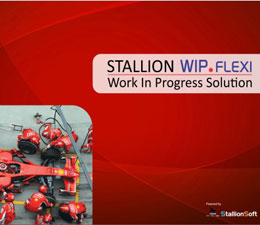Software
Work in Progress Applications
- Work in process (WIP) or in-process inventory includes the set at large of unfinished items for products in a production process. These items are not yet completed but either just being fabricated or waiting in a queue for further processing or in a buffer storage. The term is used in production and supply chain management.
- Work in progress is a key element in lean manufacturing. It is the single most important visual indicator reflecting the level of waste a system contain. And as we identified with this post inventory and WIP can be a waste by itself.
- Optimal production management aims to minimize work in process. Work in process requires storage space, represents bound capital not disponible for investment and carries an inherent risk of earlier expiration of shelf life of the products. A queue leading to a production step shows that the step is well buffered for shortage in supplies from preceding steps, but may also indicate insufficient capacity to process the output from these preceding steps.
- Just-in-time production is a concept to reduce work in process with respect to a continuous configuration of product. Just in Sequence is a similar concept with respect to a scheduled variety in sequence of configurations for products.
- Barcode and RFID identification can be used to identify work items in process flow. For locating the products additional requirements must be considered to ensure not only presence of work items, but also knowledge of the whereabouts of these items. This is a mandatory condition in flexible production lines with paralleled work positions for single steps of production.
Key Results of WIP
- Greater Visibility & Accuracy of Raw Material and Production Parts.
- Auto-ID technology and manufacturing work-in-process visibility can help you with materials management functions within the assembly plant—from body shop to end-of-line testing.
- Help reduce downtime and increase on-time delivery with RFID or other Auto-ID readers that trigger replenishment by automatically signaling when containers are empty.
- Support parts sequence verification from receiving to final assembly line delivery by tagging items, cases or pallets.
- Deliver virtual real-time visibility and increase quality by automatically tracking work-in-progress status on semi-finished assembly through the production process.
- Help reduce mistakes with assembly process verification and alerts when semi-finished items or batches are routing to the wrong manufacturing cell.
- Speed urgent production orders with priority identification and alerting.
- Continuous improvement in quality
- Cost is reduced
- Elimination of waste
- Manufacturing time is cut down
- Better productivity
- Lower Work in progress
- Better supplier relationships
- Cost efficient production
- Defect free output
Advantages of the WIP
- Real time Traceability
- Easy to identify failures of product at each stages.
- Increase the productivity.
- Helps the management to take corrective action to avoid continuous failures.
- Ease of information management.
- Works orders are tracked through the production process using shop floor data collection terminals, providing costs and times for jobs.
- Captures in-process quality control data, live, on the shop floor.
- Provides a complete audit trail and quality control results detailing who worked on what and when.
- Displays specific, detailed work instructions at each step in the manufacturing process.
- Provides lot control and complete inventory batch or part history.
- Provides real-time shop floor management data for scheduling and purchasing.
- Illustrates real-time visibility of all shop floor activity for management.
- Supports seamless handling of re-work and scrap, including lot control.
- Provides real-time bar-coded driven employee time tracking and inventory movement.
- Enables the company to go completely paperless.






Stallion_global –
WIP management plays a pivotal role in improving operational efficiency and aligning processes with lean manufacturing principles, making it an essential component for optimizing production systems.